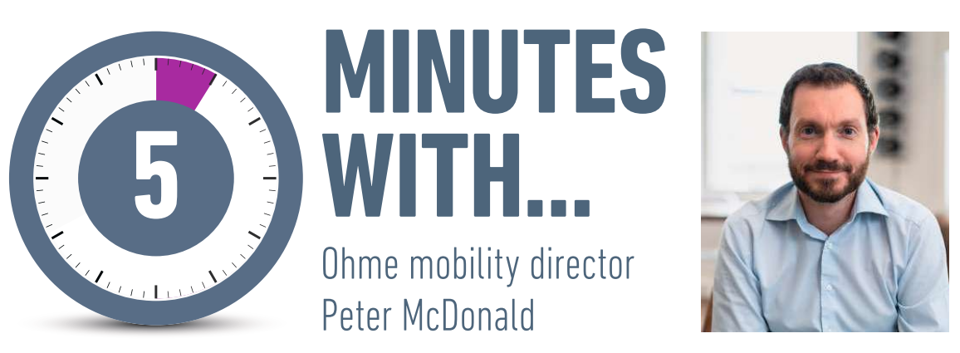Ohme mobility director Peter McDonald discussed the value of connected home charge points to mitigate against electric vehicle (EV) charging costs and demands on the National Grid in AM's latest '5 Minutes With...' automotive supplier interviews.
What was your journey into your current role?
I was originally recruited by Volkswagen and worked in Wolfsburg. I moved to China for a while and worked as part of a Volkswagen joint venture in Shanghai. When I came back, I worked at Seat and Cupra in planning, responsible for sales forecasting and supply chain. More recently I moved into fleet, managing that for Seat and Cupra before moving into a similar role at Nissan. It was while at Nissan that I was introduced to Ohme as part of the process of helping fleets to electrify. It was a product that was able to save customers money on their charge and provide fleet data. So I got to know Ohme and eventually came over to the business around a year ago.
What is Ohme’s background?
The founder is David Watson. He was a big investor in renewable energy firms, particularly across the UK and Ireland. He identified that when there was a big peak in energy demand there were these big diesel-powered generators that were able to produce more for the National Grid. When the UK goes to 100% renewable energy from 2035 there is going to be a future where those diesel-powered plants don’t exist, so it’s vital that we have smart devices that work in harmony with the grid to balance supply and demand. An electric vehicle (EV) is quite unlike the fridge in your home; it’s parked on your driveway all night, but might only take three hours to charge. David devised a cable that would transmit a multitude of signals and that was later integrated into a smart home charger. Put simply, the information the system gathers can help EV owners save money by charging their car at the right time.
Tell us a bit more about the importance of the technology and how it is being implemented by Ohme.
Our product identifies the vehicle and the size of the battery. We’d like to know if it’s a 40kWh battery and if it’s 50% charged, for example. We then want to know the tariff information and, predominantly, we want to know the cheap hours within the owner’s contract. The third thing we ask for is the commuting schedule. Government introduced some new legislation in July which meant that a charger had to respond to a signal and have randomised delays on it. Everyone’s cheaper tariff starts at midnight, they didn’t want everyone’s charge to start at that exact time and blow the grid.
How affordable can off-peak charging be?
Ohme is facilitating the Octopus EV energy tariff. The price is 7.5p per kWh at off-peak times. You need one of our chargers to be eligible for that tariff, which is made possible through us because we can give Octopus some control over when they charge EVs. More and more people are more closely scrutinising what their energy costs are and how they can reduce them, so this plays right into those concerns.
What is the scale of Ohme today and who are its key clients?
Ohme employs around 100 people. Our head office is in the UK and we have an operation in Ireland and sell into Europe. We manufacture in China. Ohme is now one of the biggest players in residential EV charge points in the UK. We manage the charging requirements of Motability customers, and they sell 240,000 vehicles a year with a charge point part of the package provided with each EV. We’re scaling up the business and growing and it’s a really exciting time, especially with our new partnership with Volkswagen Group UK. All their (VW, Seat, Škoda and Cupra) dealerships have our point-of-sale material now and we’re in the process of making the transition smooth. The Volkswagen Group network is in excess of 500 retailers, so that represents a huge opportunity of for us. Retailers aren’t compelled to sell the Ohme product, but we hope they will see the benefits and go with it. We’re remunerating the dealers for converted leads. They’re never going to make as much money from us as from GAP insurance or paint protection, but we still want it to provide a useful profit stream.
A new British standard for public EV chargers has just been launched as a result of a partnership between Motability and the British Standards Institute (BSI). How do those considerations impact Ohme?
We’ve been working with Motability for some time. We’ve opened up different modes of communication and processes that are human-assisted. We even recognised that sometimes it was a challenge when we require some information from a household to fit a charger. It was difficult for some customers to take photos for us, for example. As a result, we now have a concierge service where we have a team that can take care of all of that.
What is the biggest challenge you face as a business?
The big thing right now is the lead times on EVs are six, 12 or 18 months. When that changes, and the used market gets bigger, there will be a new crop of EV customers who will want their charge point installed tomorrow.















Login to comment
Comments
No comments have been made yet.